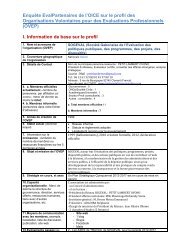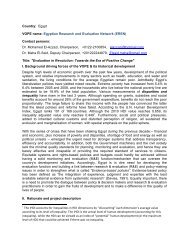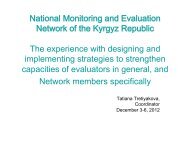44 Soojung JangThis test-based selection procedure, which <strong>in</strong>fluences what k<strong>in</strong>d of social position a personwill have <strong>in</strong> the future, causes people to be overly concerned. <strong>The</strong>refore, many people have cometo have negative feel<strong>in</strong>gs towards be<strong>in</strong>g evaluated. <strong>The</strong>y are frequently <strong>in</strong>timidated by theexam<strong>in</strong>ation <strong>in</strong> particular, and by be<strong>in</strong>g evaluated <strong>in</strong> general. Aside from college entrance, highlevelcivil servants, who are believed to hold one of the most honorable jobs <strong>in</strong> Korea, areselected through very competitive, open exam<strong>in</strong>ations. So be<strong>in</strong>g successful <strong>in</strong> tak<strong>in</strong>gexam<strong>in</strong>ations is one way of gett<strong>in</strong>g a high social position <strong>in</strong> Korea. Many Koreans recall"test<strong>in</strong>g" when they hear of evaluation. Accord<strong>in</strong>gly, the exam anxieties are serious.<strong>Evaluation</strong>, especially <strong>in</strong> the field of education, has significantly concentrated on themeasurement of academic achievement. It is unlikely that "exam anxiety" will be relieved anytime soon, even though educational reform is tak<strong>in</strong>g place at a systemic level. For example,college recruitment without test<strong>in</strong>g, shift<strong>in</strong>g primary and secondary school focus to pupilorientation, and self-leadership education that encourages creativity and character development(Lee, 1998). At the same time, there has been a grow<strong>in</strong>g reflection on the fact that education todate has concentrated on the accumulation of <strong>in</strong>formation, that is to say, acquir<strong>in</strong>g technicalknowledge while ignor<strong>in</strong>g the nurtur<strong>in</strong>g of a sense of <strong>in</strong>tellectual responsibility anddevelopment. Educational evaluation has centered on outcome based test<strong>in</strong>g, not on the learn<strong>in</strong>gprocess. Its focus has been a summative test<strong>in</strong>g, not a formative one. <strong>The</strong>re have been very feweducational evaluations that consider the multiple dimensions of persons and social programs <strong>in</strong>a systematic way beyond the simple evaluation of a paper and pencil exam. <strong>The</strong>re exists neither<strong>in</strong>digenous evaluation standards nor persons to develop or employ them.MethodIn October 1998, a workshop was conducted at Syracuse University <strong>in</strong> Syracuse, NewYork, to exam<strong>in</strong>e the appropriateness of Jo<strong>in</strong>t Committee <strong>Standards</strong> for a Korean sett<strong>in</strong>g.Participants <strong>in</strong>volved <strong>in</strong> the workshop were 21 graduate students at Syracuse University whohave ever been <strong>in</strong>volved <strong>in</strong> an evaluation project at government, bus<strong>in</strong>ess or education sett<strong>in</strong>gs.Eleven participants were high level Korean civil servants, and seven participants were corporatemanagers. <strong>The</strong> others were educators, soldiers, etc.<strong>The</strong> workshop began with one-hour lecture by Soojung Jang about the Jo<strong>in</strong>t Committee<strong>Standards</strong>, 2nd edition. She provided all participants with a detailed description on the Jo<strong>in</strong>tCommittee <strong>Standards</strong>. After the lecture, she distributed 5-likert scale questionnaires, and askedparticipants to fill out the questionnaires regard<strong>in</strong>g the appropriateness of each standard for aKorean sett<strong>in</strong>g. Smith's (1991) cultural model was circulated to stimulate their ideas. <strong>The</strong>y werealso asked to take notes on the reason certa<strong>in</strong> standards were appropriate or not <strong>in</strong> the openended section of the questionnaires. After the <strong>in</strong>dividual judgment about each standard wascompleted, participants and Soojung Jang discussed what standards are appropriate or<strong>in</strong>appropriate, and why. She played the role of facilitator throughout the workshop. Some peoplemay have changed their mark on the questionnaire dur<strong>in</strong>g the discussion, but the correction wasnot encouraged. All workshops were recorded for the author's use and all audiotapes were
<strong>The</strong> Appropriateness of Jo<strong>in</strong>t Committee <strong>Standards</strong> <strong>in</strong> Non-Western Sett<strong>in</strong>gs 45removed (It is a normal Korean custom to throw away any <strong>in</strong>terview record<strong>in</strong>g after thetranscription).Based on their work<strong>in</strong>g experience, participants expressed a broad range of views onseveral of the <strong>Standards</strong> discussed <strong>in</strong> this paper. Dur<strong>in</strong>g the discussion time, they often showedunanimous agreement or conflict<strong>in</strong>g op<strong>in</strong>ions. For example, almost all participants agreed withU2 Evaluator Credibility, but had different op<strong>in</strong>ions about P8 Fiscal Responsibility depend<strong>in</strong>g ontheir fields (government, education, bus<strong>in</strong>ess, etc.). <strong>The</strong> participants were 21 graduate students,so rather than generalize the results, this paper focused more on what k<strong>in</strong>d of cultural factorsdrive changes of the notion of Jo<strong>in</strong>t Committee <strong>Standards</strong>.Based on the workshop discussion, I describe unique Korean factors which can be <strong>in</strong>volved<strong>in</strong> chang<strong>in</strong>g evaluation designs, along with the typical evaluation procedures of decid<strong>in</strong>g focus,collect<strong>in</strong>g, analyz<strong>in</strong>g, <strong>in</strong>terpret<strong>in</strong>g, report<strong>in</strong>g and manag<strong>in</strong>g <strong>in</strong>formation. <strong>The</strong> structure of thispaper follows the typical steps of an evaluation project, and <strong>in</strong>dicates what would be appropriateand <strong>in</strong>appropriate standards <strong>in</strong> each step. That is, what standards can be adopted or adapted <strong>in</strong>Korean sett<strong>in</strong>g?<strong>The</strong> results of the workshop were represented <strong>in</strong> two-fold. First, the author showed adescriptive statistics from the questionnaire surveys. <strong>The</strong>n, the rema<strong>in</strong>der of this papersynthesized the workshop discussion notes. This paper did not exam<strong>in</strong>e the appropriateness of 30Jo<strong>in</strong>t Committee <strong>Standards</strong>. <strong>The</strong> first concern of this paper is not <strong>in</strong> mak<strong>in</strong>g a decision whethercerta<strong>in</strong> Standard is appropriate or <strong>in</strong>appropriate <strong>in</strong> Korean culture. Many workshop participantsagreed that some <strong>Standards</strong> could be understood <strong>in</strong> totally different ways rather than they were<strong>in</strong>appropriate. <strong>The</strong>refore, the author more focused on Korean cultural factors rather than on theorig<strong>in</strong>al <strong>in</strong>tent of the <strong>Standards</strong>. Thirteen <strong>Standards</strong> that might be highly related to Koreancultural factors were exam<strong>in</strong>ed based on workshop discussion notes among 30 <strong>Standards</strong>.<strong>The</strong> purpose of this paper is (1) to try to suggest what standards may be appropriate or<strong>in</strong>appropriate, (2) to expla<strong>in</strong> why they may be appropriate or <strong>in</strong>appropriate <strong>in</strong> consideration ofsome Korean cultural factors, and (3) to provide some useful cultural guidel<strong>in</strong>es for westernevaluators who will conduct evaluation projects <strong>in</strong> Korea.ResultsDescriptive Statistics of Questionnaire Analysis5-Likert scale (1 Not appropriate at all; 2 Somewhat <strong>in</strong>appropriate; 3 Don't know; 4 Somewhatappropriate; Very appropriate) questionnaires were used for descriptive statistics. <strong>The</strong> number oftotal participants was 21. Under each of five scale, the number of participants who chose a scalewas presented, and mean score, standard deviation, m<strong>in</strong>imum and maximum scale were shown <strong>in</strong>Table 1. Inappropriate <strong>Standards</strong> that have mean score of less than 2 (scale value: somewhat<strong>in</strong>appropriate) were highlighted.
- Page 1 and 2: The Program Evaluation Standardsin
- Page 3 and 4: The editor acknowledges the valuabl
- Page 5 and 6: ForewordOn February 18-20, 2000, th
- Page 7 and 8: Hopefully, this volume will contrib
- Page 9 and 10: 5Cross-Cultural Transferabilityof T
- Page 11 and 12: Cross-Cultural Transferability of t
- Page 13 and 14: Cross-Cultural Transferability of t
- Page 15 and 16: Cross-Cultural Transferability of t
- Page 17 and 18: Cross-Cultural Transferability of t
- Page 19 and 20: Cross-Cultural Transferability of t
- Page 21 and 22: Cross-Cultural Transferability of t
- Page 23 and 24: Cross-Cultural Transferability of t
- Page 25 and 26: Cross-Cultural Transferability of t
- Page 27 and 28: Cross-Cultural Transferability of t
- Page 29 and 30: Cross-Cultural Transferability of t
- Page 31: Cross-Cultural Transferability of t
- Page 34 and 35: 30 Nick L. Smith, Saviour Chircop a
- Page 36 and 37: 32 Nick L. Smith, Saviour Chircop a
- Page 38 and 39: 34 Nick L. Smith, Saviour Chircop a
- Page 40 and 41: 36 Nick L. Smith, Saviour Chircop a
- Page 42 and 43: 38 Nick L. Smith, Saviour Chircop a
- Page 44 and 45: 40 Nick L. Smith, Saviour Chircop a
- Page 46 and 47: 42 Soojung Jangyears. Due to the sc
- Page 50 and 51: 46 Soojung JangTable 1. Descriptive
- Page 52 and 53: 48 Soojung JangU2 Evaluator Credibi
- Page 54 and 55: 50 Soojung Janggenerous to foreigne
- Page 56 and 57: 52 Soojung Jangfeelings. This partl
- Page 58 and 59: 54 Soojung JangReporting Informatio
- Page 60 and 61: 56 Soojung JangU4 Values Identifica
- Page 62 and 63: 58 Soojung JangReferencesBecker, C.
- Page 64 and 65: 60Standards for Evaluation:On the W
- Page 66 and 67: 62 Wolfgang BeywlThe advantage of t
- Page 68 and 69: 64 Wolfgang BeywlA more direct way
- Page 71 and 72: 67Evaluating Evaluations: Does the
- Page 73 and 74: Evaluating Evaluations 69Bussmann 1
- Page 75 and 76: Evaluating Evaluations 71• Housin
- Page 77 and 78: Evaluating Evaluations 73Table 1: C
- Page 79 and 80: Evaluating Evaluations 75• Contra
- Page 81 and 82: Evaluating Evaluations 77References
- Page 83 and 84: Evaluating Evaluations 79Raven, J.
- Page 85 and 86: 81Evaluation StandardsRecommended b
- Page 87 and 88: Evaluation Standard Recommended by
- Page 89 and 90: Evaluation Standard Recommended by
- Page 91 and 92: Evaluation Standard Recommended by
- Page 93 and 94: Evaluation Standard Recommended by
- Page 95 and 96: Evaluation Standard Recommended by
- Page 97 and 98: Evaluation Standard Recommended by
- Page 99 and 100:
Evaluation Standard Recommended by
- Page 101 and 102:
Evaluation Standard Recommended by
- Page 103 and 104:
Evaluation Standard Recommended by
- Page 105 and 106:
Evaluation Standard Recommended by
- Page 107 and 108:
103AnnexThe complete list of the or
- Page 109:
Annex 105A4 Defensible Information






